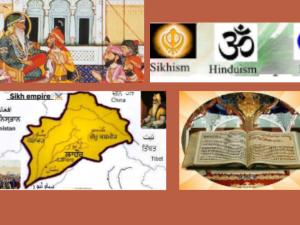Book Title : Understanding Anand
Author : Karminder Singh Dhillon, Ph. D., Director, Sikhi Vichar Forum.
Published by : Karminder Singh Dhillon, Ph. D, Kuala Lumper, Malaysia
Year of Publication : 2020; Price : NA; Pages:162 ISBN: 978-967-18161-4-1
Reviewer : Dr. Devinder Pal Singh, Director, Center for Understanding Sikhism, Mississauga, ON, Canada
Dr. Karminder Singh Dhillon is a much-acclaimed theologian, a renowned civil servant, a prolific writer and a profound scholar of comparative religious studies. Born in 1960 at Teluk Anson, Perak, Malaysia, he retired after 32 years long professional career in the Malaysian Civil Service. His incisive articles on Sikh theology have been regularly published in various international journals. Currently serving as Joint Editor for the Sikh Bulletin, USA, he, with his exceptional writing style, has established himself as an eminent exponent of the Sikh doctrines. In addition, he has published about one dozen books on various aspects of Sikhi.
Dr. Dhillon’s book 'Understanding Anand' explores the Spirituality of Bliss as outlined in 'Anand,' a composition by Guru Amar Das, the third Sikh Guru, and enshrined in Sri Guru Granth Sahib (SGGS) on pages 917-922, in Ramkali Raag. He emphasizes that Gurbani advocates a spirituality of Fearlessness and Contentment leading to Anand (bliss and Joy). He laments that our clergy is intent on promoting the Spirituality of Fear and the Spirituality of Asking, which is the antithesis of what Gurbani stands for. He enunciates that Gurbani's spiritually brilliant and divinely genius messages lead to Vigaas, the Spirituality of Bliss and Joy (Anand). In 'Foreword' of the book, Gyani Jarnail Singh Arshi points out that the translation methodology adopted by the author makes the messages of Anand hymns free from literal translation trends as well as snatan, vedic and yogic slants. The book includes three 'Introductory Essays,' i.e. (i)The Spirituality of Anand, (ii) The Methodology of This Book, and (iii) How to Read This Book. The book's last section elaborates on the Anand composition.
In the essay 'The Spirituality of Anand,' the author articulates that Contentment is the starting point of Sikh Spirituality. It starts with an internal testimony that the Creator is within oneself, leading to fearlessness and desirelessness. The author emphasizes that the rightful emotion of the Creator within oneself is Love, Reverence and Realization. On such a realization, the person's only prayer is one of Thanks, Appreciation and Gratitude in Contentment. Dr. Dhillon laments that our clergy have twisted the Gurbani meanings to promote the feeling of fear and an attitude of constant asking, begging and pleading with God.
The author emphasizes that the Spirituality of Asking reduces Spirituality to a barter transaction leading to the "hedging" of wants or the "future trading" in wants and needs. Such a spirituality negates the Creator's Hukm (Command or Will). Using appropriate quotes from Gurbani, the author emphasizes that if one must ask for something, then the person must ask for the Realization of the Creator within oneself. The only Asking accepted in Sikhi is to Ask that Asking to be eliminated. It is pointed out that while the Spirituality of Asking seeks desired outcomes, irrespective of the individual's choices, the Spirituality of Sikhi is about making the right choices to achieve the desired results. The Spirituality of Asking is about wanting a denial or change of Hukm. However, the Spirituality of Sikhi is relational, devotional, and about accepting Hukm. The author asserts that the Spirituality of Anand comprises three components: (i) the Love of the Creator, (ii) acceptance of Hukm and (iii) Contentment. Anand composition describes the Spirituality of Bliss brought about by the realization of the Shabd Guru.
In the essay "The Methodology of This Book – The Gurbani Framework," the author delineates the process he adopted in interpreting Gurbani. He points out that the objective and focus of the messages of Gurbani are to bring about a realization of the creator within the human conscience. In our everyday usage, the default mode for interpreting the messages of Gurbani is literal. But the messages within the verses cannot be ascertained from this default mode. Therefore, the discovery of Gurbani's messages requires us to cross over from the literal to the domain of spiritual messages. Although the task is arduous and challenging, the composers of Gurbani provided adequate milestones and sign boards along our spiritual journeys to ensure we get to the intended destination of the envisioned messages. The author enunciates that the Rahao verse or its equivalent is critical in interpreting and understanding Gurbani. Firstly, as each Shabd in SGGS has a poetic rendition, Rahao is the title verse. Secondly, each Shabd is composed in a particular raag, so it has a musical component. Herein Rahao is the asthai verse. Thirdly, each Shabd contains a spiritual message, so herein, the Rahao verse represents the core message of the Shabd. Therefore, the author asserts that Rahao acts as a guide, signboard or milestone for getting to the real messages. Thus, the Rahao or its equivalent verse must be understood to interpret Gurbani compositions. And it should be used as an anchor and base for the interpretation of the remaining verses.
In elucidating the context within a composition, the author asserts that it is provided by any or all the following four entities (i) The Rahao verse or its equivalent, (ii) the previous verse, (iii) the succeeding verse and (iv) the preceding Shabd or sub-section. Elaborating on the inner rationality of Gurbani, the author points out that this concept ties in with the Principle of Context and Gurbani Grammer. He emphasizes that the explanations and concepts used in Gurbani must be defined from Gurbani. Also, the meanings of words and pre-existing concepts deployed within Gurbani are redefined – often in a new and revolutionary way. These redefined and recalibrated meanings are always found within the SGGS, never outside. Using appropriate examples from diverse interpretations of Gurbani, the author successfully illustrated the perils of ignoring Gurbani's inner rationality and context during its interpretation.
Moreover, Inner Rationality leads to Conceptual Consistency. The author emphasizes that if the Conceptual Consistency of SGGS is ignored, it leads to the search for conceptual context outside the SGGS, for instance, Vedantic, Brahmanical or yogic concepts and contexts. Dr. Dhillon states that Gurbani is primarily composed in first-person terms, so it is a narrative of the writers' experiences, processes, choices, consequences and outcomes. Furthermore, it is an experiential narrative from the spiritual depths of their inner experiences. The author asserts that the norm is true that Gurbani is, for me, about me and addressed to me as a guide to my spiritual journey.
Deliberating on the Spirituality of the Shabd, Dr. Dhillon emphasizes that the definitive, decisive and ultimate answer regarding Shabd Guru comes from within the pages of Gurbani, in that the Shabd has been the Guru from the point of conception of Sikhi. Within the Spirituality of Sikhi, the Shabd is the essence. Thereby, the entirety of Sikhi is pivoted on the Shabd.
Explaining the Spirituality of realizing the Creator within, the author reports that the voice of one's consciousness is the Creator's voice within. The practical meaning of "Realizing the Creator Within" comes in Guru Nanak categorizing the Creator Within as a conglomeration of divine virtues. The ultimate realization of the Creator Within is to realize and become divine virtues, thereby becoming divine. In this way, Spirituality becomes a choice and a journey for the here and now. It is to be lived within the confines of one's human life from birth to death and never beyond. It replaces the Spirituality of Fear, the Spirituality of Asking and the pre-eminence of life after death.
Reporting on the Spirituality of Self, the author articulates that Guru Nanak's message that the Creator is Within oneself implies the elimination of the clergy or other third party as intermediaries in one's spiritual discoveries. Guru Nanak's Spirituality was a spirituality of the self, for the self, by the self. It was a spirituality undertaken by the self, transversed by the self, and conducted within the self. It was a spirituality whose outcomes were borne by the self and goals achieved by the self. It is pointed out that human responsibility, human choices and human intellect are the basic premises of Gurbani, Gurmat and Sikhi.
Enunciating the concept 'Using Gurbani to understand Gurbani,' the author pronounces that SGGS uses spiritual concepts, beliefs, idioms, metaphors, similes etc., (that were already in use and within the psyche of spiritual seekers of the time) with new meanings and understandings. So the redefining of these concepts are to be found within SGGS, not outside. For example, he reports that Amrit Vela is defined as a period of life that is imbued with the messages as contained within the Shabd, rather than an ambrosial hour, dawn etc., as is traditionally thought in various Indian religious practices, rituals and dogmas. According to Gurbani, there is no such thing as an auspicious or inauspicious time. Time is good or bad depending on what we do during a particular time.
Another example he provides is that of Chaar Padarath (Four blessings). These have been traditionally explained as Dharm, Arth, Kaam and Moksha. However, the Gurbani-based redefined interpretation of Chaar Padarath is the Spiritual Bliss (Elimination of Spiritual Sorrow), Spiritual Dignity attainment, Spiritual Courage (Elimination of the primal fears of death after birth), and Enlightenment (Realization of the Creator). The author has used this methodology throughout the book and termed it 'The Gurbani Framework".
In the essay "How to Read This Book," the author explains the style he followed in the book to interpret Gurbani's verses. Though the starting point of any translation is the literal, context is given its due place within the interpretations. The purpose of using the context is to get the intended meaning of the individual verses by examining them within the composition's complete and holistic narrative. As the methodology applied in the book makes the translations and interpretations starkly different from the commonly propagated/preached versions, the author has provided ample notes within sections or verses to explain why the commonly accepted translations are defective and need to be rejected.
The book's last section provides the translation and interpretation of the Ananad (Spiritual Bliss) Bani composed by Guru Amar Das. It is pointed out that this Bani is a song of spiritual love, bliss and a conversation of spiritual attainment. As Gurbani is not person specific but universal, its messages are for all of us. The author enunciates that the primary message of the composition is that once we realize the Creator Within, our mind (Ghar) becomes the abode of the Creator; the mind has it all and desires no more. Gurbani and Gurmat postulate that the need for the mind is to become the master of our senses and not the other way around.
Dr. Dhillon reports that Kachi Bani is a composition that is not Creator connecting. The command that a Sikh connects only and solely to Sachi Bani (i.e., Creator connecting Bani as enshrined in SGGS) is crystal clear in Gurbani. The author points out that Spirituality is the process of lining up one's senses, mind, and conscience into congruence; into a state where they complement each other; and into a hierarchy where the Conscience reigns supreme and the mind is subservient to one's conscience, but master of one's senses and one's senses following the dictates of a Gurbani imbued mind. Only such a state leads one to spiritual bliss (Anand).
Dr. Karminder Singh Dhillon has done a momentous work in projecting the divine thoughts of Guru Amar Das, particularly and other Sikh Gurus, in general, to the modern world through this book. After making a splendid in-depth study of various religions, along with the life and teachings of Sikh Gurus, the author has successfully attempted to project the dynamic vision of the Great Masters in the context of the contemporary socio-political milieu. The book offers an exciting bridge between the empirical and applied aspects of the great Gurus' teachings in developing Sikhism. Appropriate references and quotes from Sri Guru Granth Sahib strongly supplement Dr. Dhillon's thesis. Though there has been some repetition of Gurbani quotes and textual material in the book, it does not take the reader astray; instead, it helps clarify things. Each article is complete in itself and is a treat to read. The younger generation will likely gain much literary and spiritual knowledge from this treatise on Sikh philosophy. It is one of the best books ever authored on this topic. This book should be on all library shelves and distributed by all Gurudwaras. The Sikh youth of today must be encouraged to read works of this nature.
In conclusion, I would like to add that "Understanding Anand" has the potential to inspire countless readers/learners around the world and gives them a unique insight into the concept of Spiritual Bliss as outlined in SGGS. It is a timeless book to be rightly treasured by all learners and truth seekers. Dr. Karminder Singh Dhillon deserves the credit and appreciation of the Sikh community for diligently, painstakingly, and untiringly working to make this excellent book a reality.






